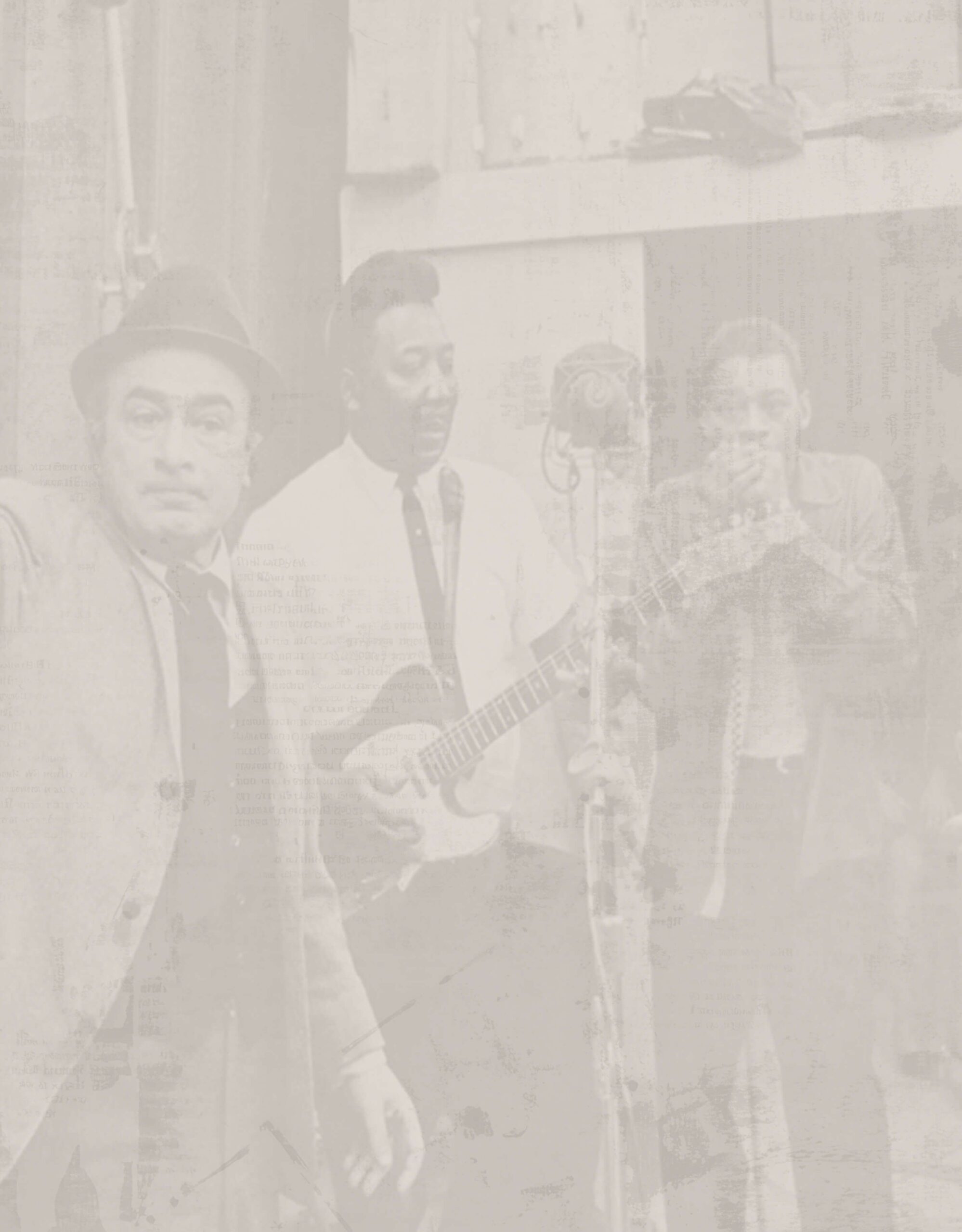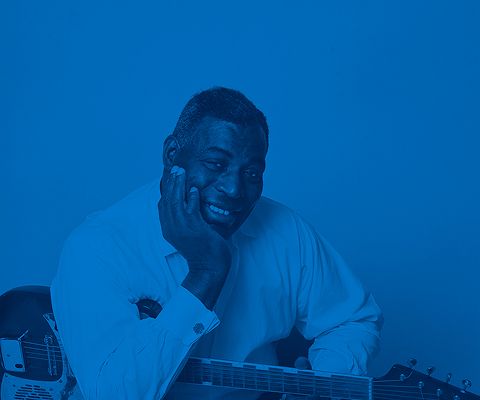Howlin’ Wolf
Howlin’ Wolf
“His eyes would light up, you’d see the veins come out on his neck, and, buddy, there was nothing on his mind but that song. He sang with his damn soul.” - Sam Phillips, Sun Records founder
Stage names rarely get more expressive than Howlin’ Wolf, the singer and guitarist who helped reshape the blues from its early, acoustic roots in the Mississippi Delta to its striking electric transformation through Chess Records’ Chicago-based roster. Not content to break new ground in America, he’d undertake a series of recording sessions and live sets throughout Europe that galvanized fans and followers around the world.
He was born Chester Arthur Bennett in White Station, Mississippi in 1910, and endured a volatile childhood. (His grandfather inspired his nickname, after seeing the young Bennett roughhousing a brood of baby chicks and promising that he’d be taken by wolves as punishment.) By the time he bought his first guitar at 17, he towered over most of his family, standing 6’3” and 275 pounds.
His playing would start to stretch out after he stopped by a juke joint and struck up a conversation with the man entertaining the crowd: blues legend Charley Patton. In time, Patton was teaching Bennett songs as well as tricks to do with his instrument, which would dazzle his growing audiences. Bennett also idolized the sound of country singer Jimmie Rodgers, but early attempts to emulate his unique vocal style proved that his destiny lay elsewhere. “I couldn’t do no yodelin’,” he’d later tell Rolling Stone. “So I turned to howlin’.” He’d round out his stage presence with solos on harmonica, taught to him by blues harpist (and future Chess signee) Sonny Boy Williamson II.
After some time in Arkansas - where he labored as a farmer when not performing - and a stint on various U.S. Army bases during World War II (including one in Georgia, where his guitar playing inspired a local shoeshine boy named James Brown), Howlin’ Wolf would reach a larger audience when he was seen by Memphis musician and talent scout Ike Turner, who urged him to put some of his recordings on tape at the local Sun Studio. His first recording there, 1951’s “Moanin’ At Midnight,” would be licensed by Sun’s owner Sam Phillips to Chess for distribution; within a year, they signed him exclusively, and Wolf moved to Chicago to assemble a new band there.
Though Wolf’s Chess recordings were never major sellers - the 1956 original “Smokestack Lightning” was one of his only Top 10 R&B singles - they were treasured by listeners and musicologists for helping bend the blues toward a more literally and figuratively electric presentation. His imposing stage presence helped him stand out in clubs, as did his willingness to give the spotlight to younger members of his band, from longtime sideman Hubert Sumlin to up-and-comer Buddy Guy. His long standing rivalry with fellow Chess grandmaster Muddy Waters helped inspire house songwriter Willie Dixon to turn out some of his best compositions for both men; Howlin’ Wolf would put his stamp on tunes like “I Ain’t Superstitious,” “Spoonful” and “Little Red Rooster,” a pivotal U.K. No. 1 for The Rolling Stones.
Indeed, England’s newest hitmakers adored Wolf’s style so much that, when they were tapped to appear on the American music program Shindig! in 1965, they insisted Wolf appear, too. This helped the bluesman reach a younger and, eventually, more European audience: he’d tour Europe with the American Folk Blues Festival in 1964 and record a landmark session in 1970 with a cast of British all-stars including Eric Clapton, Steve Winwood and The Rolling Stones’ Ian Stewart, Bill Wyman and Charlie Watts, released a year later as The London Howlin’ Wolf Sessions. (Not all of his crossover attempts were as successful: 1969’s The Howlin’ Wolf Album, backed by members of the psychedelic soul combo Rotary Connection, was openly disliked by Wolf himself, to the extent where Chess made his disdain a focus of the text-only album cover.)
Despite a series of health setbacks in the ‘60s and ‘70s, there was little anyone could do to keep Howlin’ Wolf from the stage. His final performance, two months before his death in 1976, was so raucous that he earned a minutes-long standing ovation, during which he was revived by paramedics backstage. Howlin’ Wolf’s influence on electric blues continued to echo through the 20th century, when he received posthumous honors by the Blues Hall of Fame (1980), the Rock and Roll Hall of Fame (1991) and the inaugural class of the Memphis Music Hall of Fame (2012), plus placements for “Smokestack Lightning” in the Grammy Hall of Fame (1999) and the Library of Congress’ National Recording Registry (2009).
Stage names rarely get more expressive than Howlin’ Wolf, the singer and guitarist who helped reshape the blues from its early, acoustic roots in the Mississippi Delta to its striking electric transformation through Chess Records’ Chicago-based roster. Not content to break new ground in America, he’d undertake a series of recording sessions and live sets throughout Europe that galvanized fans and followers around the world.
He was born Chester Arthur Bennett in White Station, Mississippi in 1910, and endured a volatile childhood. (His grandfather inspired his nickname, after seeing the young Bennett roughhousing a brood of baby chicks and promising that he’d be taken by wolves as punishment.) By the time he bought his first guitar at 17, he towered over most of his family, standing 6’3” and 275 pounds.
His playing would start to stretch out after he stopped by a juke joint and struck up a conversation with the man entertaining the crowd: blues legend Charley Patton. In time, Patton was teaching Bennett songs as well as tricks to do with his instrument, which would dazzle his growing audiences. Bennett also idolized the sound of country singer Jimmie Rodgers, but early attempts to emulate his unique vocal style proved that his destiny lay elsewhere. “I couldn’t do no yodelin’,” he’d later tell Rolling Stone. “So I turned to howlin’.” He’d round out his stage presence with solos on harmonica, taught to him by blues harpist (and future Chess signee) Sonny Boy Williamson II.
After some time in Arkansas - where he labored as a farmer when not performing - and a stint on various U.S. Army bases during World War II (including one in Georgia, where his guitar playing inspired a local shoeshine boy named James Brown), Howlin’ Wolf would reach a larger audience when he was seen by Memphis musician and talent scout Ike Turner, who urged him to put some of his recordings on tape at the local Sun Studio. His first recording there, 1951’s “Moanin’ At Midnight,” would be licensed by Sun’s owner Sam Phillips to Chess for distribution; within a year, they signed him exclusively, and Wolf moved to Chicago to assemble a new band there.
Though Wolf’s Chess recordings were never major sellers - the 1956 original “Smokestack Lightning” was one of his only Top 10 R&B singles - they were treasured by listeners and musicologists for helping bend the blues toward a more literally and figuratively electric presentation. His imposing stage presence helped him stand out in clubs, as did his willingness to give the spotlight to younger members of his band, from longtime sideman Hubert Sumlin to up-and-comer Buddy Guy. His long standing rivalry with fellow Chess grandmaster Muddy Waters helped inspire house songwriter Willie Dixon to turn out some of his best compositions for both men; Howlin’ Wolf would put his stamp on tunes like “I Ain’t Superstitious,” “Spoonful” and “Little Red Rooster,” a pivotal U.K. No. 1 for The Rolling Stones.
Indeed, England’s newest hitmakers adored Wolf’s style so much that, when they were tapped to appear on the American music program Shindig! in 1965, they insisted Wolf appear, too. This helped the bluesman reach a younger and, eventually, more European audience: he’d tour Europe with the American Folk Blues Festival in 1964 and record a landmark session in 1970 with a cast of British all-stars including Eric Clapton, Steve Winwood and The Rolling Stones’ Ian Stewart, Bill Wyman and Charlie Watts, released a year later as The London Howlin’ Wolf Sessions. (Not all of his crossover attempts were as successful: 1969’s The Howlin’ Wolf Album, backed by members of the psychedelic soul combo Rotary Connection, was openly disliked by Wolf himself, to the extent where Chess made his disdain a focus of the text-only album cover.)
Despite a series of health setbacks in the ‘60s and ‘70s, there was little anyone could do to keep Howlin’ Wolf from the stage. His final performance, two months before his death in 1976, was so raucous that he earned a minutes-long standing ovation, during which he was revived by paramedics backstage. Howlin’ Wolf’s influence on electric blues continued to echo through the 20th century, when he received posthumous honors by the Blues Hall of Fame (1980), the Rock and Roll Hall of Fame (1991) and the inaugural class of the Memphis Music Hall of Fame (2012), plus placements for “Smokestack Lightning” in the Grammy Hall of Fame (1999) and the Library of Congress’ National Recording Registry (2009).


